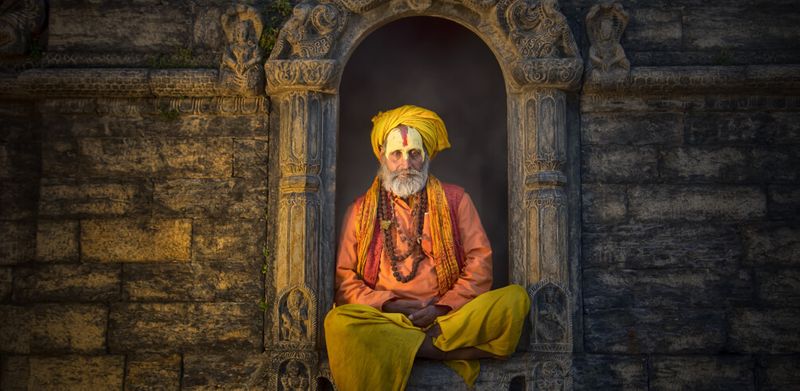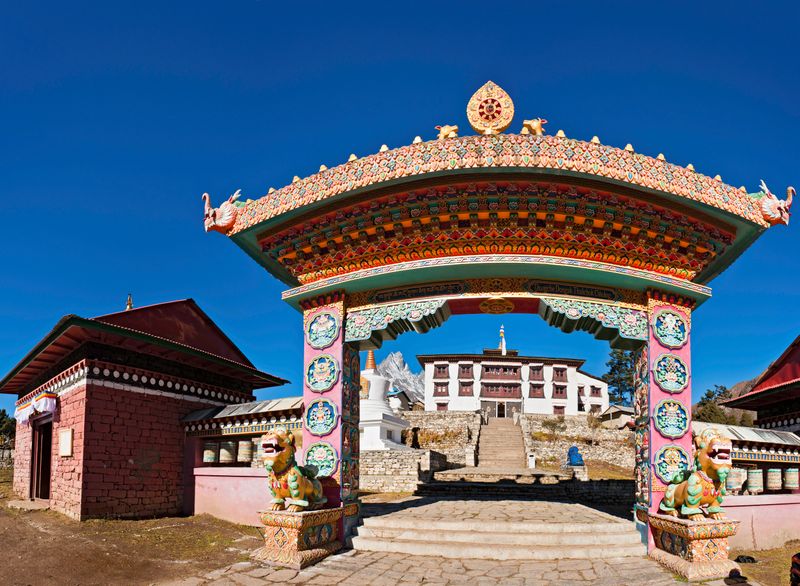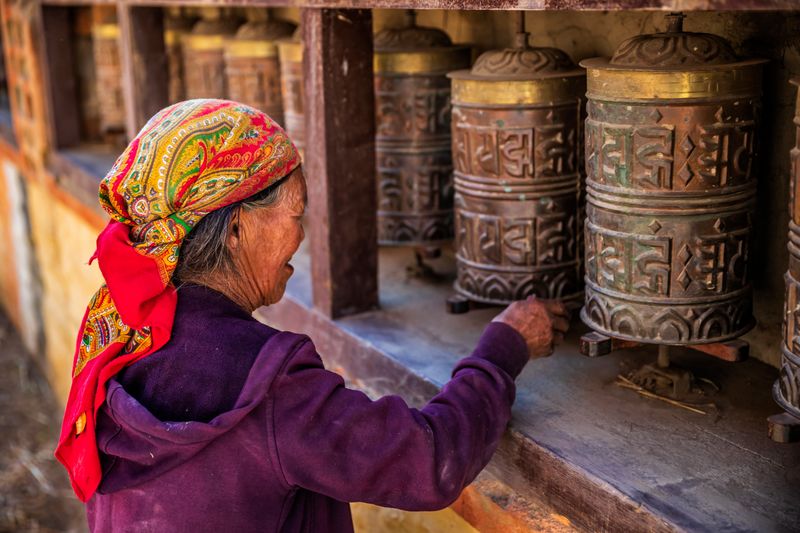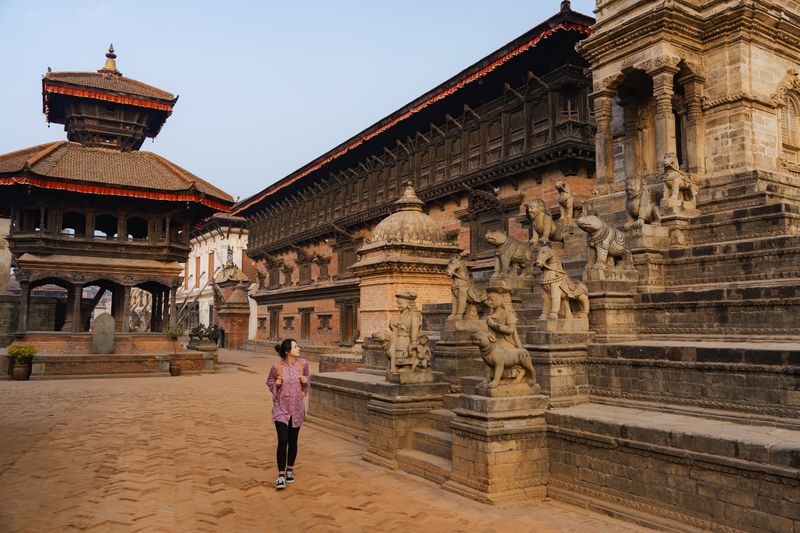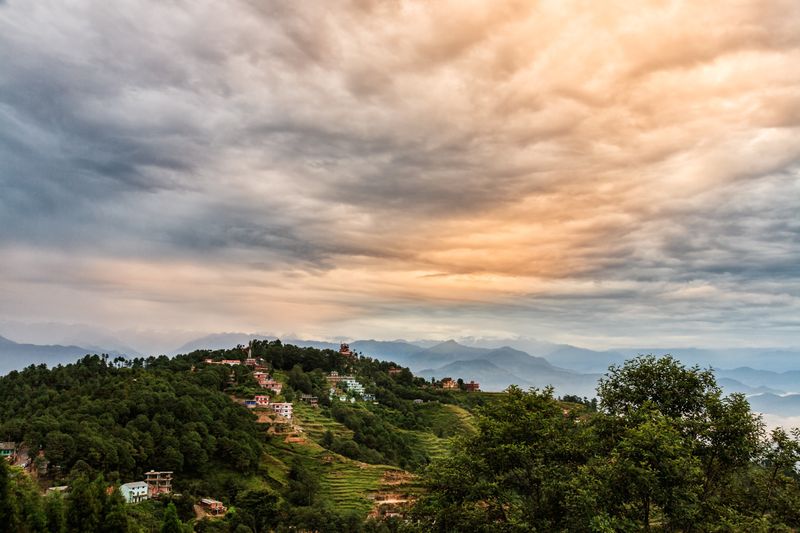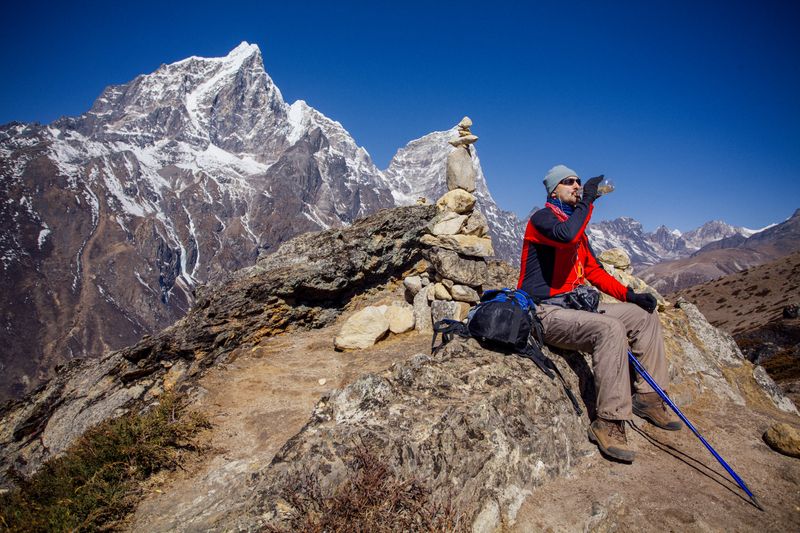Nepal is a country where the spiritual past lives on in the present. Nestled in the Himalayas, it is a land of ancient temples, sacred mountains, and living traditions. From the early roots of Hinduism and the origins of Buddhism in Nepal, to the arrival of Islam and Christianity, and even the influence of Communism, the religion in Nepal is a story of deep devotion, cultural fusion, and spiritual resilience.
Hinduism in Nepal: Origins and development
The history of Hinduism in Nepal begins around 2000 BCE, when it spread from India’s Indus Valley into what is now the Kathmandu Valley. However, archaeological evidence suggests that the earliest known Hindu religious practices in the Kathmandu Valley date back to the 3rd century CE during the Licchavi period. At that time, Nepal was not a unified nation, but a mosaic of small kingdoms and tribes.
The story goes that a sage called Ne moved to the Kathmandu Valley where he performed religious ceremonies—known as Pala—to protect the inhabitants. This led to one of the many possible origins of the country’s name: Ne Pala—or protected by Ne.
Today, over 81% of Nepalese identify as Hindu, and the Hindu god Shiva is the Guardian deity of the country. One of the oldest Hindu temples in Nepal and one of the most holy sites in Hinduism is the Pashupatinath Temple, on the banks of the Bagmati River, which was originally built in the 5th century.
It is here that bodies of the recently departed are put on ghats to be burned before their ashes are swept into the Bagmati River. Colourful Sadhus—or Holymen—covered in ash with long hair and painted faces are dotted around, offering prayers or studying sacred texts—still present today, much as they were 1,500 years ago.
The birth of Buddhism in Nepal (500 BCE)
Nepal is also the birthplace of Buddhism, through the figure of Siddhārtha Gautama, born in Lumbini in the 5th century BCE. Known as the Buddha, his teachings would go on to change the spiritual path of millions around the world.
His birthplace, Lumbini, has become one of the most sacred pilgrimage sites in the world and is home to 25 Buddhist monasteries. Of them, Maya Devi Temple is the most holy, dating back 2,200 years and said to be built on the exact place where Buddha was born.
While only about 9% of Nepalese people practise Buddhism in Nepal today, its presence is vibrant in the mountainous regions. The ethnic Sherpa people who live high in the Himalayas are mostly practising Buddhists, and many Buddhist Monasteries can be seen in the region.
These include the Kopan Monastery outside Kathmandu, the Chhairo Gompa on the Kali Gandaki River, and the Tibetan-style Amitabha Monastery. The incredible Tengboche Monastery in the Sherpa community has panoramic views of the Himalayas and Everest.
Religious fusion: Harmony between faiths (500 CE–1200 CE)
Between the 5th and 12th centuries, religion in Nepal took a unique turn. Rather than clashing, Hinduism and Buddhism began to blend. For the next thousand years, Tibeto-Burman Buddhists would battle with Hindu Brahmins over territory in the foothills of the Himalayas, and the two religions would often intermingle, even adopting each other’s gods. Today, Hinduism and Buddhism are not seen as rivals in Nepal but merely variations on a similar religious history. In fact, it is not uncommon for both religions to worship at the same temple.
The Malla Dynasty and Golden Age (1200 CE–1700 CE)
The Malla Dynasty ushered in a golden era for Hinduism in Nepal, as kings oversaw a cultural renaissance in art, architecture, and religious devotion.
The legacy of this period still defines much of Nepal's religious history. The 17th-century Royal Palace in Patan, the five-story pagoda Temple of Nyatapola in Bhaktapur Square, and the Old Royal Palace in Kathmandu are just a few of the many marvels of Hindu architecture produced during the Malla Dynasty, which are dedicated to Hindu gods and adorned with intricate reliefs and statues.
The arrival of new faiths: Islam and Christianity in Nepal (1600 CE -1700 CE)
The peaceful Malla period also saw the arrival of the first religions from beyond the Indian Subcontinent. Islam arrived in the late 15th century as merchants from Kashmir, Afghanistan and even Persia, arrived to trade carpets, wools and other materials. Most Muslims remained in the southern Terai region, where nearly all of Nepal’s Muslims remain today. Making up just 5% of the population they remain a small minority, but Islam has been in Nepal for over five centuries and mosques can be found in many southern towns.
In 1715, Christianity in Nepal arrived with Italian Capuchin missionaries. Their early impact was limited, but they laid the groundwork for the growth of Christianity in Nepal during the modern era. Today, Christians make up a small but growing portion of the population.
Unification and Hindu Nationalism (1768–1950)
While the Malla Dynasty controlled the Kathmandu Valley, the nearby Gorkha Kingdom was growing in strength and in 1768 Prithvi Narayan Shah declared himself the Maharajadhiraja—the first king of unified Nepal. The Gorkha King Shah’s army—whose skill in war craft is still recognised in today’s Gerkhas—took control of the Kathmandu Valley and other neighbouring kingdoms unifying much of what we recognise as present day Nepal. The new Hindu King closed the borders, expelling foreigners including the Catholic missionaries.
The Shah King and his successors battled hill tribes in the Himalayas, expanded north into southern Tibet and fought Britain’s East India Company in the south, in an attempt to gain as much ground as possible. They succeeded on many fronts but after defeats to the British, the weakened Shah Royals ceded power to Prime Minister Rana who formed an alliance with the British and whose successors would go on to rule with an iron fist until 1951.
Revolution and religious freedom (1950–Present)
The mid-20th century brought revolution, democracy, and eventually the fall of the monarchy. In 2008, the 240-year-old Hindu kingdom was abolished, and Nepal became a secular republic. Today, religion in Nepal is officially separated from the state, though traditions remain deeply ingrained.
As Nepal opened to the world, Christian missionaries returned, contributing to education and healthcare. This helped spur the growth of Christianity in Nepal, though Christians still represent just 1.4% of the population.
For travellers, Nepal offers more than just mountains—it’s a place where you can walk through living history, feel the power of prayer wheels spinning, and stand where sages and kings once sought the divine.
Visiting Nepal: Sacred sites and spiritual landscapes
Whether you're a spiritual seeker, a curious traveller, or history lover, Nepal offers an immersive journey you won’t forget.
1. Kathmandu Valley
A vibrant cultural hub, home to some of Nepal’s most sacred and historically significant temples, stupas, and palaces.
- Pashupatinath Temple—Major Hindu pilgrimage site, especially during Shivaratri, a major Hindu festival dedicated to Lord Shiva.
- Boudhanath Stupa—A Buddhist sanctuary surrounded by monasteries and prayer flags.
- Swayambhunath (Monkey Temple)—Shared by Hindus and Buddhists alike.
- Bhaktapur Durbar Square—A treasure trove of Hindu temples and palaces.
- Changu Narayan Temple—Nepal’s oldest temple, dedicated to Vishnu.
2. Nagarkot
Famous for panoramic Himalayan views—a serene spot for sunrise meditation or yoga retreats.
3. Pokhara
A scenic lakeside city nestled beneath the Annapurna range, known for its tranquil atmosphere, natural beauty, and spiritual landmarks.
- Bindhyabasini Temple—Dedicated to the goddess Bhagawati, set in the old bazaar.
- Gupteswar Cave—A Shiva cave temple stretching 3 km deep.
- Begnas and Rupa Lakes—Peaceful lakes for spiritual reflection away from the crowds.
4. Sarangkot
A hilltop village just outside Pokhara, famed for its sunrise views over the Himalayas and the Sarangkot viewpoint, a 25-minute hike which leads to vistas of the Annapurna range, perfect for sunrise watching and photography.
5. Mount Everest
Known as Sagarmatha in Nepali and Chomolungma in Tibetan, Everest is not only the world’s tallest peak but a sacred mountain revered in local spiritual traditions.
- Everest Region—Trek through Buddhist Sherpa villages, visit remote monasteries like Tengboche, and witness prayer flags fluttering against the Himalayas—a truly spiritual high point of any journey in Nepal.
6. Chitwan
Located in Nepal’s southern Terai region, Chitwan offers a unique blend of cultural diversity and lush wildlife, where religion and nature coexist.
- Visit the Terai region—Explore the presence of Islam in Nepal through local mosques and the long-standing Muslim communities in the area.
- Chitwan National Park—Take a boat safari or jungle walk to experience Nepal’s wild side, where the natural world is deeply connected to local spirituality and tradition.
In Summary: Religion in Nepal
- Nepal’s religious landscape is one of the most diverse and harmonious in the world.
- Hinduism remains the dominant faith, deeply woven into Nepal’s culture and history.
- Buddhism began here and still thrives, especially in Himalayan regions.
- Islam and Christianity in Nepal have long histories and continue to grow as minority religions.
- Nepal’s unique history has allowed different faiths to blend rather than conflict, creating shared sacred spaces.
- Temples, stupas, mosques and monasteries are not just monuments—they’re part of daily life.
- Today, Nepal is a secular nation that celebrates freedom of religion and spiritual expression.
- For travellers, Nepal offers a rare chance to explore both spectacular landscapes and living spiritual traditions.
Ready to be inspired by travel? Explore our curated tours across Asia and beyond. Visit Inspiring Vacations to explore our exciting range of tours today.
